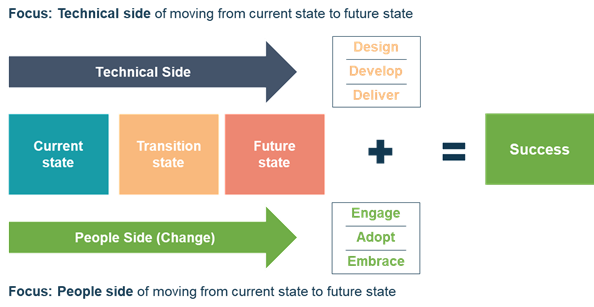As the nights draw in, the distinct chill in the air has me looking forward to the cosy nights, bonfire night, Halloween and beautiful changing colours of Autumn. To others it signifies the end of summer, and the onset of winter and comes with a feeling of dread.
The changing of the seasons can bring joy and excitement to some but a sense of loss and disquiet to others. It made me reflect on change; how it is ever-present in our daily lives and how differently people experience change.
If we recognise and acknowledge these feelings and understand how different people experience different changes, we can learn to support people better to navigate change, and go on to build a healthy and resilient change capability in our organisations.
Building an organisation capable of embracing change, managing it effectively and making it part of your DNA, ensures an agility to react to business challenges such as technology changes, economic and environmental impacts on the organisation.
Building a change capability in your organisation will help you deliver projects to people. It will help to bring your people along on your strategic journey and make your organisation a more open, transparent and agile environment to work in. Here are some tips to begin creating that change capability:
Set a vision and future state
What would success look like in your organisation? Understand and communicate your vision, objectives and benefits to your employees and help them be a part of the journey. Inspire your employees and empower them to be a part of the success.
- Set measurable, achievable goals and track progress
- Keep the vision alive throughout the project and celebrate even the small wins
- Create the right environment / culture for change capability to flourish
- Engage your employees from the beginning by encouraging ownership of aspects of change through delegation and decision making
The change process starts with individuals. It is people that form the culture of an organisation and the resilience of the individuals in an organisation contribute to the approach to change. These people will be your change agents; people who sit in the business functions and who will bring the change message to team meetings and project huddles. These are your advocates for change, who will go on the journey with you.
Empower Employees
How does the working environment contribute to your team’s work? Teams empowered to make decisions related to change in their area are likely to take greater accountability for those changes.
Give permission for your teams to try new ideas. Encourage innovation by seeing failure as a learning opportunity and a platform for iteration and improvement.
Foster resilience in your teams by providing support systems such as mental health resources and wellness programs to help employees cope with the stress of change.
Often, change and transformation programmes demand more intense working. By providing flexible working such as remote working and flexible hours it helps the employees to not only feel empowered, but to help them achieve a better work life balance while committing to work demands.
Get Executive Buy-In
Where does Change sit on your Board? Maybe HR will mention training or the Marketing Director will talk about comms. Or is it even mentioned at all?
By aligning the change to wider strategic objectives you can encourage further executive buy-in, especially by highlighting how change will contribute to those objectives.
Values are driven from the top. Behaviours and actions are showcased by senior leaders. You can demonstrate your commitment to change by having a place on the Executive Board or at least on the senior leadership team which represents change. This way change is driven throughout the organisation and becomes a part of every conversation.
Change should be as much a part of a technology project as the technology
Figure 1: PROCSI Unified Value Proposition

When you run change alongside your technology deployment, it positively affects the hearts and minds of the people, allowing the adoption of that technology to land well and with minimal disruption to the organisation. It allows your employees to pivot through the deployment and be ready to catch the solution when it lands.
Using change management techniques to bring employees on the journey can reduce nervousness. Providing clarity about the purpose of the technology, timelines, and how it will impact roles can reduce uncertainty and anxiety.
Often the adoption of the technology defines the real success of the project. No matter how innovative the technology, if people don’t know how to use it, or use it to its full potential, the project will not achieve the ROI that it set out to achieve.
Communication
Open and clear communication is essential for cultivating an open and honest culture.
Transparency and consistent messaging along with opportunities for two-way discussions to allow the employees to be heard will foster a sense of trust and openness, which helps to alleviate uncertainties. Quality engagement will encourage support for the change and this in turn will help deploy the project smoothly.
Also explore our change capability tool.
What next?
If you know you need to build change capability in your organisation, but have no idea how to get started then we are here to help. Our change capability build workshop can upskill your team and improve change leadership. Find out more here.




